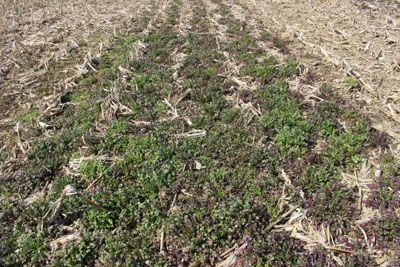
- An effective burndown is the start to an effective weed management program.
- Winter annual weed species are dense and actively growing in many fields.
- Use multiple effective sites of action, apply an effective rate of the herbicides, and utilize the correct adjuvants to aid in a successful burndown.
How many times in the last few years have you heard "start clean, stay clean" in regards to weed control? If you spend any significant time reading about agriculture or listening to the radio, this phrase is a common occurrence. Generally, this brings thoughts about an integrated weed management program that utilizes preemergence herbicides followed by effective postemergence herbicides to control those species that emerge in season. That is definitely a good plan of action, but what is missing? That's right—an effective burndown!
Effective burndowns are essential to the "start clean, stay clean" mantra, especially in our no-till environments. As this spring has progressed, many of our fields have a carpet of winter annuals growing on top of the soil. Not only are they dense, they are starting to become excessively tall. The first step to a successful weed control program is to manage these weeds prior to planting our crop.
When choosing the best herbicides for the job, we must first determine what weed species are present in our fields. Some of our weed species, such as marestail, are resistant to glyphosate which creates additional challenges when creating our mix. With all of our herbicide options, there is more than one way to end up with a successful burndown. Without putting all of these options in writing, we can make generalizations about the similarities of these programs.
Successful burndowns tend to use multiple effective sites of action in each tank. Many times a burndown application may skimp on the extra herbicide added to the tank to save a few dollars. Sometimes it works, but it costs even more when it doesn't work. Many times the extra site of action to the tank provides enough activity to kill the remaining weeds.
Another factor to consider would be the rate of the herbicide. Not only do we need to include that extra site of action to the tank, we must choose an effective rate of that herbicide. Rate integrity ensures that we have enough active ingredient on the acre to be successful.
The last commonality with good burndown programs has to be the inclusion of adjuvants to help the herbicides be more effective on the target species. Most of the time a water conditioner is used because glyphosate is a part of the burndown. What about other adjuvants? Many times a surfactant (FS AquaSupreme™) or crop oil (FS COC Supreme™) may be needed to help hydrate or penetrate the cuticle of the weeds. Some herbicides require the use of an adjuvant. An example of this would be with Sharpen®, which requires the addition of MSO (FS Optique™) to ensure that the herbicide is effective. Always check the herbicide label to determine which adjuvants may help us be more successful.
As we gear up to start our burndown applications, remember that they are essential to the overall success of our weed management program. Making sure we are using the right herbicide, an effective rate of the herbicide, and the right adjuvants with the herbicide will help to create a mixture that will be successful in managing the winter annual weeds that are invading our fields.
Contact your FS Crop Specialist for your agronomic needs.
Image 1. A dense population of winter annual weeds.